Schlepping and Schmoozing Along the Interstate 5, Chapter 11, Exit 7B (Marina Parkway): Bayside Park, Chula Vista
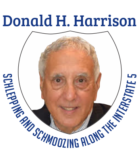
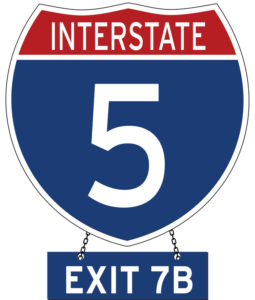 Exit west to Marina Parkway and follow it as it curves north to Sandpiper Way, turn left on Sandpiper Way and follow to Plover Way, which runs into Bayside Park Address is 999 Bayside Parkway.
Exit west to Marina Parkway and follow it as it curves north to Sandpiper Way, turn left on Sandpiper Way and follow to Plover Way, which runs into Bayside Park Address is 999 Bayside Parkway.
When we think of a ritual bath, known as a mikvah, in Judaism, we typically picture an Orthodox mikvah in which there are changing rooms, showers, and a knowledgeable supervisor who will instruct someone who is converting to Judaism to thoroughly clean himself or herself, removing jewelry or any other objects from the body. Then the naked candidate must descend seven steps into a special pool, where that person immerses three times, and intones blessings acknowledging God’s laws concerning immersion, thanking God for allowing the person to arrive at this particular moment, and finally reciting the
, declaring that God is One!
In San Diego County, there are several mikva’ot, typically situated at or near an Orthodox synagogue. While these are available for people who convert to Judaism under Orthodox auspices, people who convert under the rules of other streams of Judaism (for example, Conservative, Reform, Reconstructionist) must look for other locales. In some cases, Conservative conversion candidates would drive up to American Jewish University (formerly known as the University of Judaism) in Los Angeles, where after answering questions posed by three rabbis of a beth din (rabbinical court), they would then utilize the mikvah on the campus grounds and complete the conversion process.
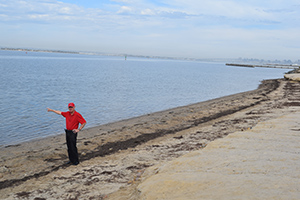
However, there are other ways that the process of conversion can be completed, much closer to home, as Dr. Mark Scheller, an anesthesiologist, learned in 2015 when he waded from the shore of Chula Vista’s Bayside Park into the cold waters of San Diego Bay. He immersed himself three times and said the customary blessings. Unlike those who are converted in an Orthodox ceremony, he was not required to shed all his clothing; instead, he wore his swimming trunks. His wife, Sandy Scheller, who observed the ceremony from the shore, was so excited that her husband was now Jewish, that when the ceremony was over, she dashed right into the water, while wearing a dress, to give him a celebratory hug.
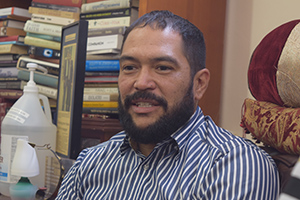
Six years later, George Carbajal, a barber, underwent his conversion ceremony, but instead of it being conducted at Bayside Park, it was done at a friend’s backyard swimming pool.
Both conversion ceremonies were officiated by Rabbi Michael Leo Samuel of Temple Beth Shalom [House of Peace], a Conservative institution. In an interview in 2021, he commented that “the Conservative movement debated early on whether a jacuzzi or a swimming pool could qualify as a de facto mikvah in the absence of a real mikvah. And the movement decided early on that was perfectly acceptable. We used to go to the water here by the Bay, but the problem is that the water is so dirty from the pollution from urban runoff and bayside industries. We didn’t want people to go to the Bay and hold their nose, so we went to the swimming pool.”
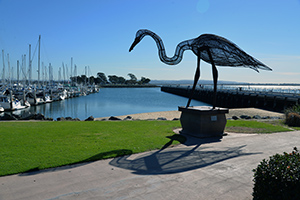
Besides the problem of pollution, there also is a large colony of sea turtles which move around on the Bay floor. The presence of wildlife is also made evident by a large sculpture of an egret, a at the southern end of Bayside Park that was sculpted by Stephen Fairfield in 2006. It’s called “The Fisherman.”
A person emerging naked from the conversion waters symbolizes rebirth, but according to Rabbi Samuel nudity is not required. “I have studied these laws and I know that if they wear something that is semi-permeable, that is perfectly suitable for conversion,” he said. “If they wear something light – a shirt, swimming suit, that is perfectly fine. The water goes right through.”
In the early part of the 20th century, many rabbis approached the problem from a more liberal perspective and allowed swimming pools or hot tubs because mikvahs were scarce in many parts of the country.
Before a person is accepted for conversion, he or she typically will appear before a beth din of three rabbis and answer questions to demonstrate both knowledge of Judaism and commitment to live a Jewish life.
However, according to Rabbi Samuel, it is not necessary for three ordained rabbis to participate in the beth din; it can be any three knowledgeable Jews. Historically, Jewish communities in Europe did not always have access to several rabbis in geographically isolated places. So, when a candidate is examined, he said, it is often done outside on his synagogue’s patio, with many congregants participating. According to the rabbi, “It takes a community to welcome a proselyte into its ranks.” Candidates are asked why they want to become Jewish and are asked about such subjects as the Jewish holidays, Israel, the Holocaust, and antisemitism. Carbajal, who was converted just prior to Rosh Hashanah 2021, described the process as enjoyable.
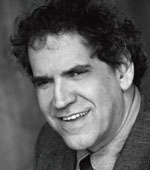
Rabbi Samuel said a book written by Rabbi Shlomo Goren – who served as Israel’s chief Ashkenazi Rabbi from 1973 to 1983 – suggests that in theory, the less a candidate for conversion knows about Judaism, the better. “When the Israelites went to Mount Sinai (from which Moses brought down the Ten Commandments), they said ‘We will do, and we will learn.’ If they were willing to accept God’s commandments and live a Jewish life, that was sufficient.”
Rabbi Samuel said, “Judaism in the first century was welcoming; it followed the approach of Hillel rather than Shamai (two early rabbis representing opposing schools of thought.). He (Hillel) worked under the assumption that it was better to bring people to Judaism and welcome them in and they could commit to the study of Judaism and Torah and they would grow in their commitment and knowledge of Judaism. They always found a way to welcome the outsider. That is my approach; that was the approach of Hillel; and it was the approach of Philo of Alexandria (who translated the Torah into Aramaic) as well – which was the principal reason why Judaism had 600,000 in the diaspora and hundreds of thousands of people in Rome who converted to Judaism.
“Then Emperor Constantine took over and made it a capital offense for any Jew to welcome a Roman citizen who had Christianized, under penalty of death. So, what did early Christians do They would go to Jews and say ‘I am thinking of converting to Judaism. Will you accept me?’ and the Jews would say ‘Yes’ and then get reported to the Church, and they would be expelled, imprisoned, or executed. That was why the rabbis became very skittish toward converts because they didn’t know if they might be secret agents for the church. So, this attitude of distrust continued throughout the Middle Ages all the way to modern times.”
Customarily, if someone asks to convert to Judaism, a rabbi will turn that person away three times to make certain he or she is sincere. But this approach is a custom, not Jewish law, according to Rabbi Samuel.
Carbajal and Scheller had different routes to conversion.
Scheller’s wife, Sandy, is the daughter of Kurt and Ruth (Goldschmiedova) Sax. Her father had immigrated to the United States from Austria as the Nazis were taking over, but Ruth, who was his distant cousin, was imprisoned by the Nazis at the Theresienstadt, Auschwitz, and Oederan concentration camps. After the war, Kurt was able to get in touch with Ruth and bring her to Anderson, South Carolina, where he proposed their marriage. They moved cross-country to Chula Vista in 1952 and became founding members of Temple Beth Sholom. (The congregation’s last name was later change from “Sholom” to “Shalom” to reflect the Sephardic pronunciation of the word used as a greeting and meaning “peace” that is used in Israel.)
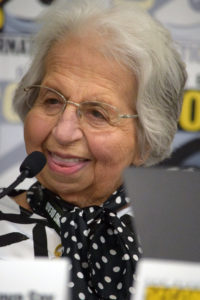
In the last years of her life, Ruth became a prominent speaker about the Holocaust, giving lectures to school children about her surviving three different concentration camps as well as the other deprivations and humiliations Jews suffered under the Nazi regime. Sandy helped organize an exhibition that lasted nearly three years at the Chula Vista Public Library called “RUTH – Remember Us The Holocaust” in which the biographies Ruth Sax and other Holocaust survivors who had moved to San Diego County were told and illustrated. Finding a permanent home for the exhibition is one of Sandy’s priorities.
The Sax family owns burial plots at the Home of Peace Cemetery in San Diego, which operates under the rule that only Jews may be buried there. Sandy, who wanted to someday be buried near her mother, also wanted her husband to be by her side for eternity. And thus began discussions about conversion for Mark, who had been raised in Milwaukee as a Catholic, but who did not feel a great attachment to that religion.
“I’m interested in religion, I studied religion, but I would define myself as not a religious person,” Mark commented. “I’m just not. … Sandy was happy that I ‘converted’ to Judaism, which is fine as I have nothing against Judaism. It is a great religion, fantastic.”
Carbajal was born in the United States, growing up both in Los Angeles and in Toluca, a city near Mexico City. Unhappy living with a Pentecostal aunt in Toluca, he “ran away” back to Los Angeles, where he enrolled at North Hollywood High School. A French language teacher there, Suzanne Feigelstock, who is Jewish, was an important influence on him. “I remember that my English wasn’t too good at that time, so she said the dictionary has all the pronunciations, and she gave me a dictionary, my first dictionary, and to this day I love dictionaries in all languages.”
Following high school, he spent six years in the Navy as an electronics technician, serving aboard two ships, calling in ports at various places in the world. Next, he went to college, eventually learning to become a professional barber. He operates the Rex Barbershop at F Street and Broadway in Chula Vista.
Fast forward some 20 years after high school when he was visiting Los Angeles and he happened into a Jewish bookstore named the House of David, where he found materials about the Carvajal (also spelled Carbajal) family and its Jewish roots. In fact, Portuguese-born Luis de Carvajal was the governor of the province of Nuevo Leon, New Spain (Mexico) from 1579 to 1588, until his arrest for turning a blind eye to his sister and her children illegally practicing Judaism in violation of the rules of the Inquisition. Sentenced to six years exile, he died in jail in 1591.
While George Carbajal does not know whether he is somehow related to Luis de Carvajal (who was the subject of The Conquistador, an opera by Myron Fink that the San Diego Opera premiered), he was excited to learn that the Carbajal family were Sephardic Jews who originally came from Portugal. If he can prove his Sephardic ancestry, he commented, he will be eligible for Portuguese citizenship.
Asked what drew him to Judaism he said it was “because of Mrs. Feigelstock. It was so amazing that she was my French professor but spoke Spanish – her husband is from Uruguay – and that made me feel at home. She was like a second mother to me, and the fact that she introduced me to books. To me that, books, is the Jewish thing to do.” Soon he was learning more and more about Sephardic history. So enamored of Judaism did he become that he had himself circumcised at a hospital in Tijuana in preparation for conversion.
“I have been studying by myself, but Rabbi Samuel also has been giving me lots of books like Pirke Avot, and one of the books he wrote about Maimonides, and I love the stories that are there. I love the fact that in Judaism, you are encouraged to ask questions.”
One biblical formulation refers to the “God of My Fathers” and for Carbajal the concept resonated. On the assumption that his family were among the Carbajals who were “conversos” – Jews forced to convert to Christianity – “I want to make up for those lost years that my family has been in exile. So, I am actually getting back home.”
Next Sunday, March 20, 2022: Exit 8A (H Street): Temple Beth Shalom
*
This story is copyrighted (c) 2022 by Donald H. Harrison, editor emeritus of San Diego Jewish World. He may be contacted via donald.harrison@sdjewishworld.com